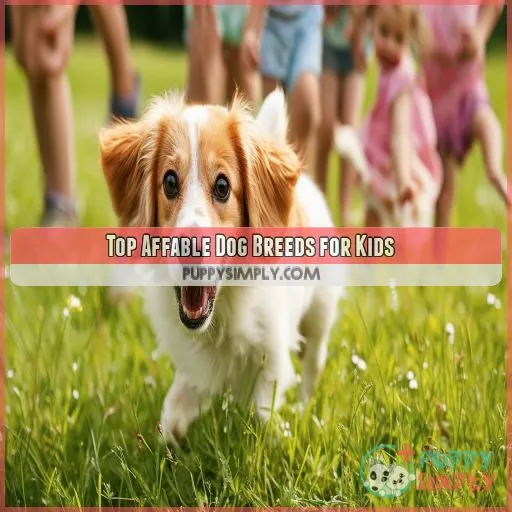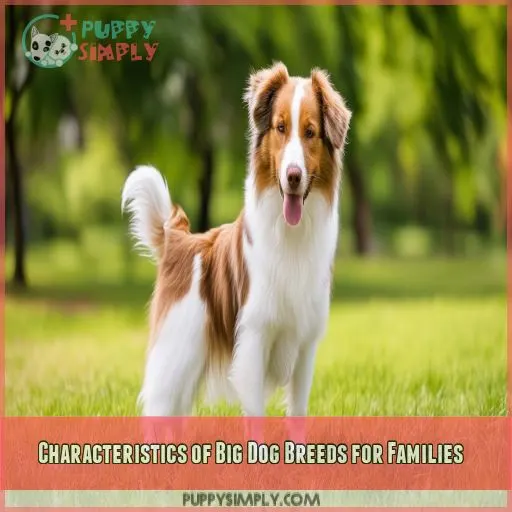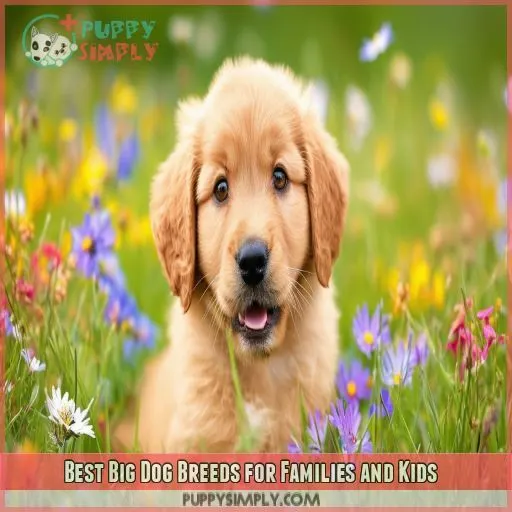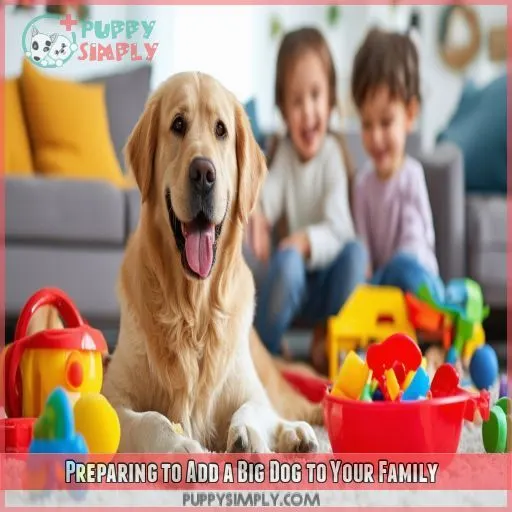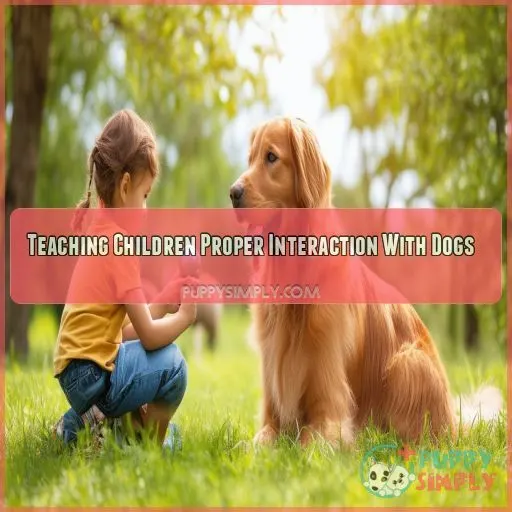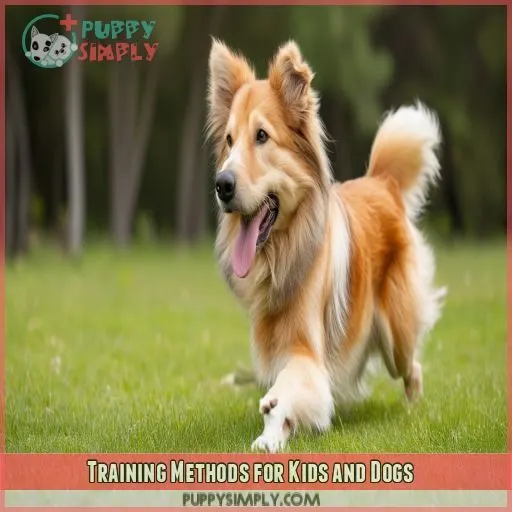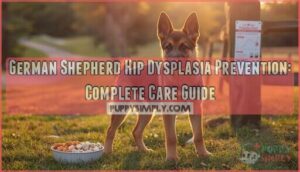This site is supported by our readers. We may earn a commission, at no cost to you, if you purchase through links.
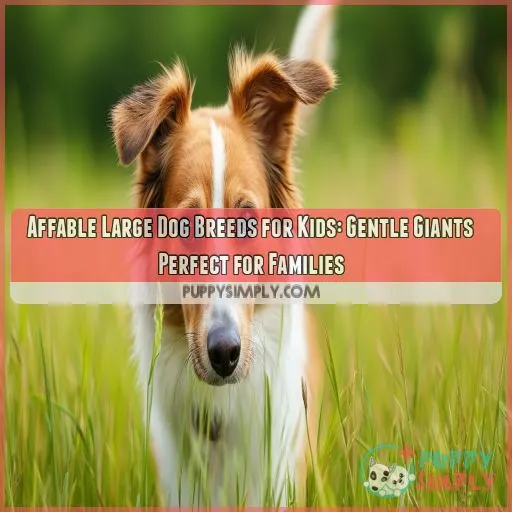
That’s the magic of affable large dog breeds for kids. These canine companions offer more than size; they’re living teddy bears with hearts of gold.
You’ll discover breeds that combine strength with gentleness, perfect for active families.
From patient Newfoundlands to playful Great Danes, these dogs provide love, protection, and endless fun.
Learn which gentle giants might be the ideal match for your family’s unique needs and lifestyle.
Table Of Contents
- Key Takeaways
- Top Affable Dog Breeds for Kids
- Characteristics of Big Dog Breeds for Families
- Best Big Dog Breeds for Families and Kids
- Preparing to Add a Big Dog to Your Family
- Affable Dog Breeds for Specific Circumstances
- Factors Influencing Affability in Dog Breeds
- Teaching Children Proper Interaction With Dogs
- Key Qualities Making a Dog Breed Suitable for Kids
- Training Methods for Kids and Dogs
- Frequently Asked Questions (FAQs)
- Which big dog breeds are most suitable for families and children?
- Which dog breeds are a good family-friendly dog breed?
- Which dog breed is best for beginners?
- Are dog breeds good for families with children?
- How do large dogs impact home insurance premiums?
- What are the average lifespans of affable large breeds?
- Do large dogs require special vehicles for transportation?
- How much do affable large breeds typically cost annually?
- Are there weight limits for large dogs in apartments?
- Conclusion
Key Takeaways
- Gentle giants: Large dog breeds can be the perfect playful yet protective companions for kids, offering loyalty, affection, and a soft, cuddly experience.
- Affable options: Breeds like Newfoundlands, Great Danes, Labrador Retrievers, and Golden Retrievers are known for their patient, gentle, and friendly natures, making them ideal for active families.
- Characteristics count: When choosing a large dog breed, consider the temperament, size, socialization needs, energy levels, and grooming requirements to ensure a good fit for your family and lifestyle.
- Preparation is key: Before bringing your furry friend home, it’s essential to find a veterinarian, purchase suitable essentials like a crate and an orthopedic bed, and select nutritious food to support your dog’s health and happiness.
Top Affable Dog Breeds for Kids
In the quest for an ideal canine companion for your children, large, amiable breeds stand out.
These gentle behemoths tend to exhibit greater patience and tolerance than their diminutive counterparts.
Labrador Retrievers and Golden Retrievers reign supreme, renowned for their affable nature and intelligence.
They’re highly trainable and foster harmonious child-dog relationships.
Newfoundlands, often hailed as "nanny dogs," exude gentleness, affection, and unwavering loyalty towards their families.
Collies, reminiscent of the iconic Lassie, are playful and protective, making them exceptional watchdogs.
The German Shepherd isn’t to be overlooked, a breed as intelligent as it’s devoted.
With the right approach, these breeds can become lifelong companions, providing your children with safety, companionship, and cherished memories.
Characteristics of Big Dog Breeds for Families
When considering big dog breeds for your family, you’ll want to look for certain characteristics that make them ideal companions.
These gentle giants often have friendly temperaments and are patient with kids, but their size means you’ll need to factor in space requirements and cost of feeding.
Health considerations are critical, so research breed-specific issues before making a decision.
Some families prefer hypoallergenic options to minimize allergy concerns.
Early exposure to children and proper socialization are key to developing a strong bond.
While many large breeds are known for their affectionate nature, each dog is unique.
Look for traits like intelligence, loyalty, and playfulness to guarantee a good fit.
With the right choice, you’ll find a furry friend that becomes an integral part of your family’s adventures.
Best Big Dog Breeds for Families and Kids
You’ll find that large dog breeds can make excellent companions for families with kids. Some of the best options to contemplate include the gentle Basset Hound, the loyal American Pit Bull Terrier, the intelligent German Shepherd, the affectionate English Bulldog, and the protective Doberman Pinscher.
Basset Hound
You’ll find Basset Hounds to be gentle giants with a laid-back personality. They’re affable and patient, making them perfect for families. Training and moderate exercise keep them happy.
American Pit Bull Terrier
While Bassets are laid-back, Pit Bulls bring energy to families. They’re affable, keen to please, and thrive with positive reinforcement. Debunk stereotypes through proper training and socialization.
German Shepherd
German Shepherds, gentle giants with a rich history, are known for their loyalty and intelligence. They’re affable companions for kids, with a lifespan of 9-13 years and trainable temperament.
English Bulldog
You’ll adore English Bulldogs’ gentle nature. These wrinkly giants are perfect for families, but they’re not hypoallergenic. With proper training and socialization, they’ll become loyal, low-energy companions.
Doberman Pinscher
You’ll find Doberman Pinschers are more than meets the eye. These loyal guardians boast:
- Unwavering devotion
- Intelligence for easy training
- Surprising gentleness with kids
Their sleek appearance belies a loving nature.
Preparing to Add a Big Dog to Your Family
Before bringing home your new furry family member, it’s essential to prepare adequately for their arrival. You’ll need to find a veterinarian, purchase a high-quality crate and orthopedic mattress, stock up on suitable toys, and select nutritious food to guarantee your big dog’s well-being and happiness.
Find a Veterinarian Before You Pick Up Your Dog
Before bringing your new furry friend home, find a trusted veterinarian. They’ll guide you through vaccinations, check-ups, and emergency care, ensuring your big dog’s health and happiness from day one.
Purchase a High-quality Crate for Your New Dog
When choosing a crate for your giant schnauzer or old English sheepdog, consider size, location, and material. Proper crate training guarantees a safe haven for your new companion.
Get Your New Dog an Orthopedic Mattress
After crate training, invest in an orthopedic mattress for your new pup. It’ll provide comfort and support, especially for large breeds like Great Danes or Saint Bernards.
Provide Your Dog With Plenty of Good Toys
After settling your big dog’s bed, focus on toys. Provide a variety of safe, durable options for chewing and interactive play to prevent separation anxiety and guarantee mental stimulation.
Select a High-quality Food
Selecting high-quality food is paramount for your gentle giant’s health. Seek out large breed-specific options that support healthy weight and address potential allergies. Feeding frequency matters too!
Affable Dog Breeds for Specific Circumstances
Now that you’re prepared to welcome a big dog, let’s explore breeds that excel in specific situations. Every family’s needs are unique, and finding the perfect canine companion means considering your lifestyle and circumstances.
For families with pet allergies, hypoallergenic breeds like the Bichon Frise or Portuguese Water Dog can be ideal. These furry friends shed less and produce fewer allergens, making them a great choice for allergy-prone households.
If you’re an active family, high-energy breeds like the Boxer or Irish Wolfhound might be perfect companions for your adventures. They’ll keep up with your friendly activities and outdoor escapades.
For those new to dog ownership, consider breeds known for their easy-going nature:
- Norfolk Terrier: Small but mighty, perfect for child-led training
- Labrador Retriever: Patient and adaptable to various family dynamics
- Golden Retriever: Gentle giants with a knack for breed-specific socialization
Factors Influencing Affability in Dog Breeds
When considering affable large dog breeds for kids, you’ll need to account for several key factors that influence a dog’s suitability for family life. These include the breed’s temperament, size, socialization needs, energy level, and grooming requirements, all of which play essential roles in determining how well a dog will integrate into your household.
Temperament
A dog’s temperament, shaped by genetics and upbringing, plays a key role in family compatibility. Consider breeds like Alaskan Malamutes or Beagles, known for their friendly dispositions.
Size
When choosing a large dog breed, consider your space and budget. Bigger breeds like Irish Wolfhounds need more room and food than compact ones like Brittany Spaniels.
Socialization
Socialization shapes your dog’s affability with kids. Consider these factors:
- Early exposure to children
- Positive family interactions
- Consistent training for respect
Rescue dogs may need extra patience during socialization.
Energy Level
You’ll want to match your family’s lifestyle with your dog’s energy level. High-energy breeds like Australian Shepherds need more exercise, while calmer ones suit less active households.
Grooming Needs
When choosing a large dog, consider grooming needs. Some breeds, like St. Bernards, shed heavily, while others are hypoallergenic. Coat type affects brushing frequency and shedding levels.
Teaching Children Proper Interaction With Dogs
Teaching children how to properly interact with dogs is essential for both the child’s safety and the dog’s well-being. You’ll need to cover important aspects like respecting the dog’s space, ensuring adult supervision during interactions, maintaining proper hygiene, practicing safe feeding habits, and helping children understand basic dog behavior.
Respecting Dogs
Teaching kids to respect dogs is essential. Building on breed characteristics, here’s how to foster positive interactions:
- Learn dog body language
- Practice obedience training together
- Research breeds thoroughly
- Implement safety precautions
Adult Supervision
Always supervise your child’s interactions with dogs. Watch for signs of stress in both. Here’s a guide to guarantee safe, positive experiences:
| Child’s Action | Dog’s Response | Adult’s Role |
|---|---|---|
| Gentle petting | Relaxed posture | Encourage |
| Rough handling | Growling | Intervene |
| Respecting space | Wagging tail | Praise |
| Feeding treats | Excited jumping | Guide |
Hygiene
Teach your kids proper hygiene around dogs. Regularly brush their fur, trim nails, and clean ears. Don’t forget dental care! Be mindful of hair allergies.
Safe Feeding Practices
Teach your kids about safe feeding practices for your furry friend. Establish a feeding schedule and control portions to maintain your dog’s health and nutrition.
Understanding Dog Behavior
Understanding dog behavior is essential for safe interactions. Teach your kids these key signs:
- Tail wagging: happy
- Growling: upset
- Ears back: fearful
- Yawning: stressed
Knowing these helps prevent misunderstandings.
Key Qualities Making a Dog Breed Suitable for Kids
When selecting a dog for your family, it’s imperative to evaluate key qualities that make a breed compatible with children. Beyond appropriate interaction, you’ll want to focus on dog temperament, breed size, and how they integrate into your home environment. A gentle giant should possess a patient nature and be capable of handling the exuberance of children. Consider these fundamental qualities:
| Quality | Importance | Impact on Family |
|---|---|---|
| Temperament | High | Ensures safety and harmony |
| Size | Moderate | Affects space and playtime |
| Energy Level | Variable | Matches family lifestyle |
Exercise requirements and grooming needs also contribute to compatibility. A dog that’s overly energetic might overwhelm young children, while one with high grooming needs may be challenging for families with busy schedules. Remember, the optimal breed will become a cherished member of your family, providing love and companionship for years to come.
Training Methods for Kids and Dogs
Training methods for kids and dogs are paramount for fostering a harmonious family environment. You’ll need to focus on teaching basic commands, using positive reinforcement, setting clear boundaries, and considering professional help when necessary to guarantee both your children and your new canine companion learn to interact safely and joyfully.
Basic Commands
After identifying suitable dog breeds, it’s essential to start training early. Teach your kids to use basic commands like "sit," "stay," and "come." Incorporate these training techniques into daily routines, ensuring patience and consistency for effective results.
Positive Reinforcement
Positive reinforcement is your secret weapon in dog training. Use clicker or treat-based methods to reward good behavior. Here’s why it works:
- Builds trust
- Encourages repetition
- Creates a joyful learning environment
You’ll see tails wagging in no time!
Setting Boundaries
Set clear boundaries for your kids and dogs. Implement crate training, puppy-proof your home, and establish consistent rules. Create safe play areas and guarantee supervised interactions. This approach fosters a harmonious relationship between your children and canine companions.
Professional Help
If boundaries aren’t working, don’t hesitate to seek professional help. A behavior consultant can provide customized guidance, evaluate breed suitability, and confirm safety precautions are in place during pet selection and training processes.
Frequently Asked Questions (FAQs)
Which big dog breeds are most suitable for families and children?
You’ll find Labrador Retrievers, Golden Retrievers, and Newfoundlands ideal for families. They’re gentle giants with kid-friendly temperaments. Collies and German Shepherds are also great choices, offering loyalty and protective instincts while being affectionate with children.
Which dog breeds are a good family-friendly dog breed?
Family-friendly dog breeds include Beagles, Basset Hounds, Bluetick Coonhounds, and Chinooks. Beagles are playful and cheerful, Basset Hounds are loyal, and Chinooks are patient and smart.
Which dog breed is best for beginners?
When choosing your first dog, look for a breed that’s trainable, willing to please, and friendly. Consider your energy and attention level, and whether you want a dog that’s athletic, or a calm lapdog. Some good options for beginners include the Golden Retriever, Labrador Retriever, Papillon, and Poodle.
Are dog breeds good for families with children?
Yes, many dog breeds are good for families with children. Popular breeds include Labradors, Golden Retrievers, Beagles, Irish Setters, and Newfoundlands. Each dog is unique, but these breeds are known for their kindness and energy.
How do large dogs impact home insurance premiums?
Large dogs, especially those considered aggressive, may increase your home insurance premiums. Insurers may restrict certain breeds or increase your rates due to the potential for more severe injuries if a bite occurs.
What are the average lifespans of affable large breeds?
Large dog breeds typically live between 8 and 12 years, with giant breeds tending to live shorter lives of 8 to 10 years. This is likely due to larger dogs developing age-related diseases sooner than smaller dogs.
Do large dogs require special vehicles for transportation?
Large dogs don’t require special vehicles, but they do need enough space in your car. Some US states require dogs to be restrained or in the cargo space. Public transport policies vary, but some allow large dogs.
How much do affable large breeds typically cost annually?
Let’s say you’re considering a friendly, large dog breed for your family, like a Labrador Retriever.
While these dogs can be great companions, their annual costs can vary.
On average, large dog breeds cost $580 to $2,115 annually, with food costs ranging from $200 to $1,
Other expenses include pet health insurance, which can be around $108 per month, and miscellaneous items like dog bowls and containers, with an average annual spend of $
Are there weight limits for large dogs in apartments?
Yes, apartments often have weight limits for dogs, ranging from 25 to 50 pounds. These limits are in place to prevent property damage, noise complaints, and issues with other tenants.
Conclusion
A dog is a man’s best friend, and a child’s gentle giant.
This article has explored the perfect pooches for families, offering strength and softness in one furry package.
From patient Newfoundlands to playful Great Danes, you’ve discovered breeds that provide love, protection, and fun.
Now, you’re ready to choose a canine companion, creating a harmonious home with a new family member.

